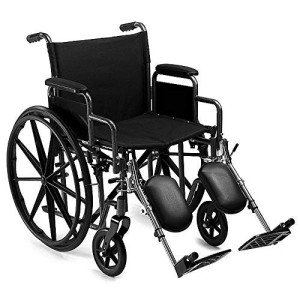How To Make A Profitable Bariatric Wheelchair 24 Inch Seat Entrepreneur Even If You're Not Business-Savvy

Bariatric Wheelchair Seat Width
Seat Width

Having the proper seat width is crucial to wheelchair users who spend longer periods in their chairs. Too narrow a seat will cause pressure on the hips and thighs which could result in sores or pressure points. Having too wide a seat can likewise make it difficult for the user to reach the hand rims to move themselves or maneuver in small areas.
To determine the correct seat width an individual would sit on a chair normally and have their measurement taken across their lap at the largest point which is typically their hips. A wheelchair determining tape can be used to determine this, but a lawn stick is chosen as it avoids individuals from covering the tape around their hips which would offer an incorrect result.
The basic wheelchair seat width is 16" (narrow grownup), 18" (basic adult), and 20" (wide adult). For bariatric patients, a 24" seat is readily available. This sturdy additional large bariatric wheelchair from Medline includes swing-away footrests, a carbon steel frame with rust- and chip-resistant chrome plating, and easy-to-clean vinyl upholstery. It has a weight capacity of 500 pounds.
Seat Depth
Generally, the seat depth of a bariatric wheelchair was included 2" to the measurement taken at the user's widest point (normally their hips). This was meant to accommodate additional layers of clothing that might be worn during cold weather condition. Nevertheless, this practice is becoming less common as wheelchair users are able to spend more time inside and are not wearing long coats. This makes the seat depth of a chair lesser when selecting a bariatric wheelchair. However, it is still crucial to select an alternative that provides appropriate assistance for larger users.
The Medline folding additional broad bariatric manual wheelchair includes a comfortable 24" seat width and a durable slide tube silver vein frame. It also has an adjustable axle and tool-free elevating legrests.
Seat Height
When it comes to determining the right wheelchair seat width you should always measure from the user's best point which is generally their hips. bariatric self propelled wheelchair will likewise require to think about whether the user is going to be wearing a winter season coat as this might include 2" to the width needed.
When a wheelchair is in usage it need to only be operated on level surfaces with the wheel locks completely engaged. This is to avoid the chair from being able to move inclines that are 10 degrees or greater. It is also important to keep in mind that any activity that may move the center of mass in the chair must be finished with care. This includes reaching for items that need the person to lean out of their seat or attempting to stand up from it.
Whenever you have the chair in usage it is recommended that you frequently examine it for damage and oil any areas that are deemed essential. For instance, the casters ought to be lubricated by removing the caster fork and using a multi-purpose grease to use to the caster stem bearings. Also, the foot plates can be changed by loosening the bolt and then moving them to the preferred position. This permits the feet to sit comfortably on the footplate and prevents any pressure points from forming. This can be extremely uncomfortable for the user and if left unattended, can lead to press sores.
Weight Capacity
Bariatric wheelchairs are designed to support more weight than standard wheelchairs. This makes them sturdier and better equipped to handle falls. They are likewise typically larger and wider, making them less maneuverable in tight areas than standard wheelchairs. They need automobiles with special ramps and lifts to fill them, in addition to motorists who understand how to finest transport them from one location to the next.
When choosing a wheelchair, consider its weight capacity as it will be the primary determining consider whether it will accommodate your traveler's needs. The weight capacity of the chair is frequently listed as a fixed load, indicating that it indicates the amount of weight the chair can easily hold while stalling. However, some manufacturers likewise list an active load that is based upon a drop test and can simulate the effect of someone sitting down in the chair. This may be a more dependable measurement of the weight limit, depending upon your needs.
If you prepare to carry out activities that shift your center of mass in the seat (such as grabbing objects), make certain to have front casters pointed in a forward instructions and wheel locks engaged so the chair will not tip over. Likewise, check that casters are oiled routinely to prevent extreme wear and abrasions. bariatric wheel chair includes getting rid of the fork, separating the caster from the wheel, and greasing the caster stem bearings with top quality multi-purpose grease.
